Gockenbach M.S. Partial Differential Equations. Analytical and Numerical Methods
Подождите немного. Документ загружается.


498
Chapter
10.
More about
finite
element methods
Figure
10.13.
The
coarsest
mesh
from
Example
10.5.
Exercises
1.
(a)
Suppose
u, v
e
R
n
contain
the
nodal values
of
piecewise linear
functions
Uh,Vh
€ Vh,
respectively. Explain
how to
compute
the L
2
inner product
of
Uh
and Vh
from
u
and v.
(b)
Show
that
if u and v
satisfy
where
A
/
//
and K and M are the
stiffness
and
mass matrices, respec-
tively, then
the
corresponding piecewise linear functions
Uh,Vh
€
Vh are
orthogonal
in the
I/
2
inner product.
2.
The
results
of
this section
are
easily specialized
to
one-dimensional problems.
Consider
the
eigenvalue problem
where
k(x]
= 1 + x. Use finite
elements
to
estimate
the
smallest eigenvalue
A.
3.
(Hard) This exercise requires
that
you
write
a
program
to
assemble
the
stiff-
ness
and
mass matrix
for
—A
on an
arbitrary
triangulation
of a
polygonal
498
Chapter 10. More about finite element methods
1.4.-------,------r-----.----.....,
1.2
0.8
'"
x
0.6
0.4
0.2
0
-1
-0.5
0
0.5
x
1
Figure
10.13.
The coarsest mesh from Example 10.5.
Exercises
1. (a) Suppose
u,
v
ERn
contain
the
nodal values of piecewise linear functions
Uh,
Vh
E
Vh,
respectively. Explain how
to
compute
the
L2
inner product
of
Uh
and
Vh
from u
and
v.
(b) Show
that
if u
and
v satisfy
Ku
=
AMu,
Kv
= p,Mv,
where A
=I-
JL
and
K
and
M are
the
stiffness
and
mass matrices, respec-
tively,
then
the
corresponding piecewise linear functions
Uh,
Vh
E
Vh
are
orthogonal in
the
L2
inner product.
2.
The
results of this section are easily specialized
to
one-dimensional problems.
Consider
the
eigenvalue problem
d (
dU)
-
dx
k(x)
dx
=
AU,
0 < x <
1,
u(O)
= 0,
u(1)
= 0,
where k(x) = 1 + x. Use finite elements
to
estimate
the
smallest eigenvalue
A.
3. (Hard) This exercise requires
that
you write a program
to
assemble
the
stiff-
ness
and
mass
matrix
for -..6. on
an
arbitrary
triangulation of a polygonal
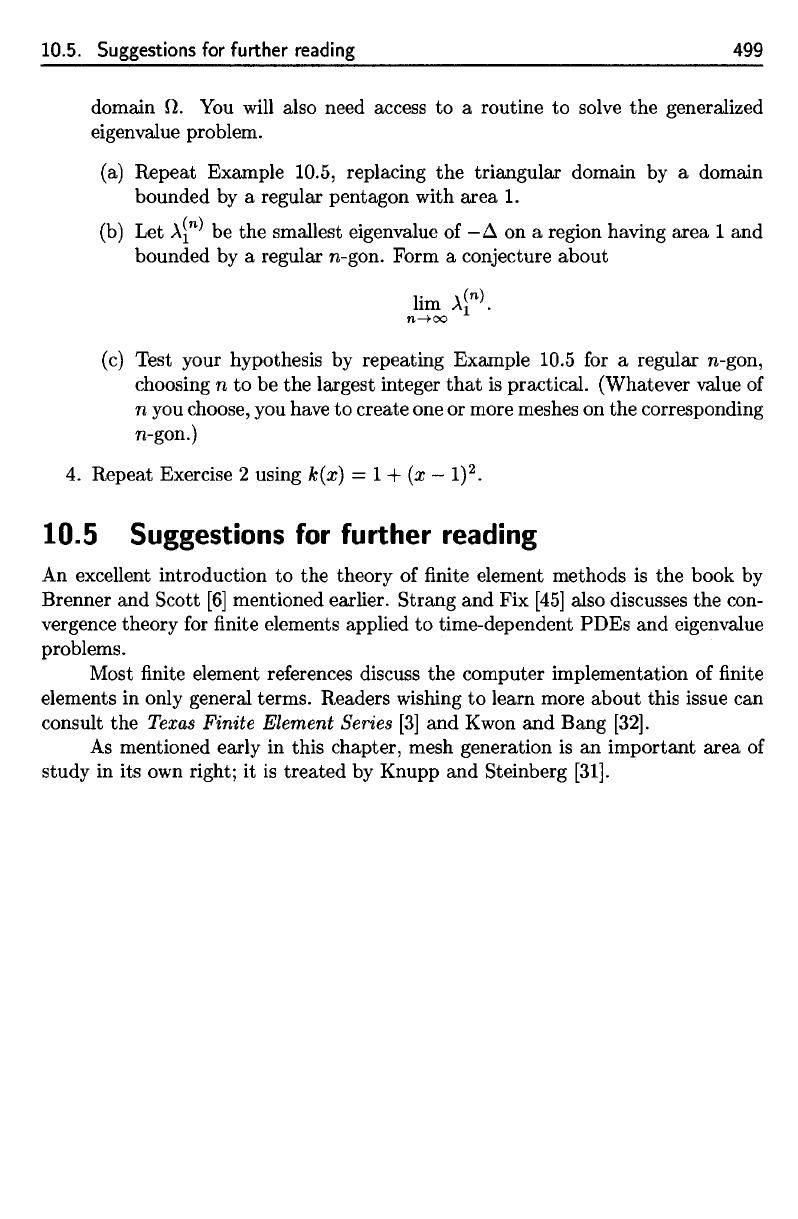
10.5. Suggestions
for
further reading
499
domain
fJ.
You
will
also need access
to a
routine
to
solve
the
generalized
eigenvalue
problem.
(a)
Repeat Example 10.5, replacing
the
triangular domain
by a
domain
bounded
by a
regular pentagon with
area
1.
(b)
Let
AI
be the
smallest eigenvalue
of
—A
on a
region having
area
1 and
bounded
by a
regular n-gon. Form
a
conjecture about
(c)
Test
your hypothesis
by
repeating Example 10.5
for a
regular n-gon,
choosing
n to be the
largest integer
that
is
practical.
(Whatever value
of
n you
choose,
you
have
to
create
one or
more meshes
on the
corresponding
n-gon.)
4.
Repeat Exercise
2
using k(x)
= 1 + (x
—
I)
2
.
10.5 Suggestions
for
further reading
An
excellent introduction
to the
theory
of
finite
element methods
is the
book
by
Brenner
and
Scott
[6]
mentioned earlier. Strang
and Fix
[45] also discusses
the
con-
vergence theory
for finite
elements applied
to
time-dependent PDEs
and
eigenvalue
problems.
Most
finite
element
references
discuss
the
computer implementation
of finite
elements
in
only general terms. Readers
wishing
to
learn more
about
this
issue
can
consult
the
Texas
Finite Element Series
[3] and
Kwon
and
Bang
[32].
As
mentioned early
in
this chapter, mesh generation
is an
important
area
of
study
in its own
right;
it is
treated
by
Knupp
and
Steinberg
[31].
10.5. Suggestions for further reading
499
domain
D.
You
will also need access to a routine
to
solve the generalized
eigenvalue problem.
(a) Repeat Example 10.5, replacing the triangular domain by a domain
bounded by a regular pentagon with area
1.
(b) Let
A~n)
be the smallest eigenvalue of
-~
on a region having area 1 and
bounded by a regular n-gon. Form a conjecture about
1
·
dn)
1m
Al
.
n-+oo
(c)
Test your hypothesis by repeating Example 10.5 for a regular n-gon,
choosing n
to
be the largest integer
that
is
practical. (Whatever value of
n you choose, you have
to
create one or more meshes on
the
corresponding
n-gon.)
4.
Repeat Exercise 2 using k(x) = 1 + (x _1)2.
10.5 Suggestions for further reading
An excellent introduction
to
the theory of finite element methods
is
the book by
Brenner and Scott
[6]
mentioned earlier. Strang and Fix
[45]
also discusses the con-
vergence theory
for
finite elements applied
to
time-dependent PDEs and eigenvalue
problems.
Most finite element references discuss the computer implementation of finite
elements in only general terms. Readers wishing
to
learn more about this issue can
consult the
Texas
Finite Element Series
[3]
and Kwon and Bang
[32].
As
mentioned early in this chapter, mesh generation
is
an
important area of
study in its own right; it
is
treated by Knupp and Steinberg
[31].

This page intentionally left blank
This page intentionally left blank
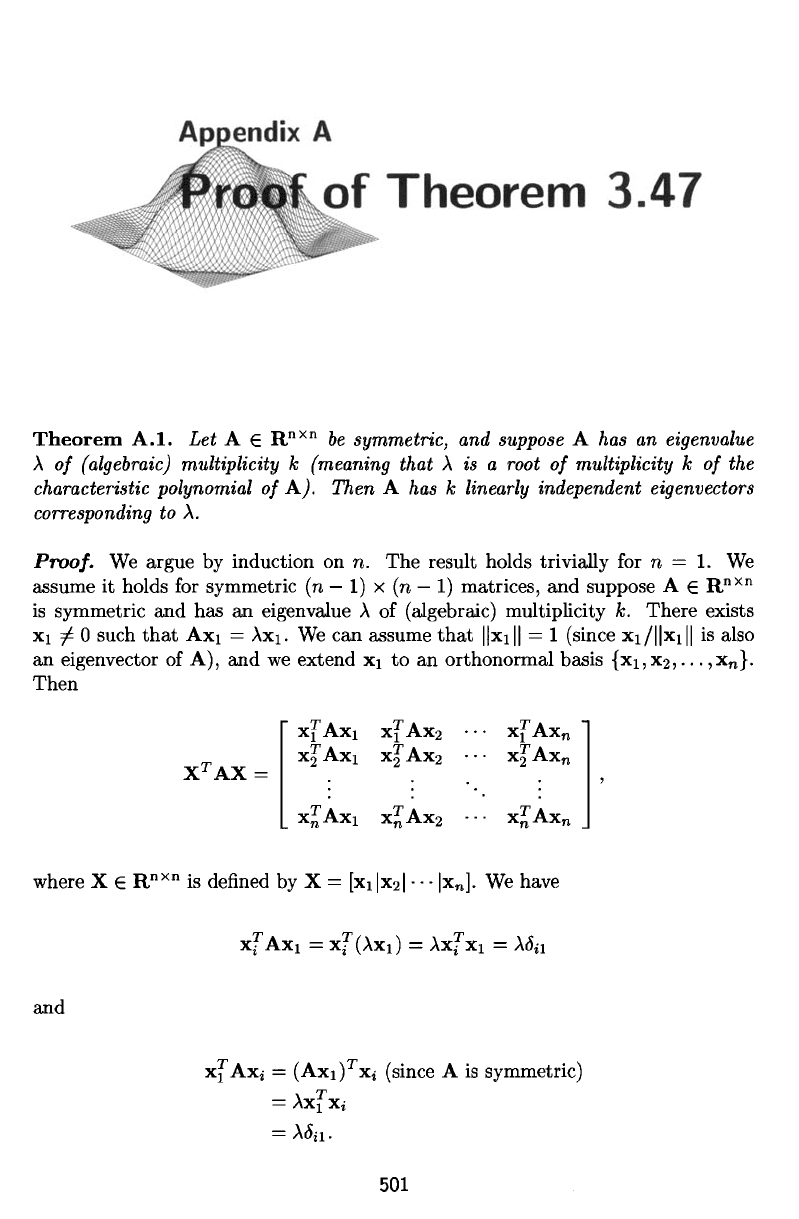
Appendix
A
Theorem
A.I.
Let A 6
R
nxn
be
symmetric,
and
suppose
A has an
eigenvalue
X
of
(algebraic)
multiplicity
k
(meaning
that
A is a
root
of
multiplicity
k of the
characteristic
polynomial
of
A).
Then
A has k
linearly
independent
eigenvectors
corresponding
to A.
Proof.
We
argue
by
induction
on n. The
result holds trivially
for
n
= 1. We
assume
it
holds
for
symmetric
(n
—
1) x (n
—
1)
matrices,
and
suppose
A
e
R
nxn
is
symmetric
and has an
eigenvalue
A of
(algebraic) multiplicity
k.
There
exists
xi
^
0
such
that
Axi
=
Axi.
We can
assume
that
||xi||
= 1
(since
Xi/||xi||
is
also
an
eigenvector
of A), and we
extend
xi
to an
orthonormal basis
{xi,x
2
,...
,x
n
}.
Then
where
X
e
R
nxn
is
defined
by X =
[xi|x
2
|
• • •
|x
n
].
We
have
and
501
Theorem
3.47
Proof of
of Theorem 3.47
Theorem
A.I.
Let
A E
Rnxn
be
symmetric, and suppose A has an eigenvalue
A
of
(algebraic) multiplicity k (meaning that A is a root
of
multiplicity k
of
the
characteristic polynomial
of
A). Then A has k linearly independent eigenvectors
corresponding to
A.
Proof.
We
argue by induction on
n.
The
result holds trivially for n =
1.
We
assume it holds for symmetric (n -
1)
x (n -
1)
matrices,
and
suppose A E
Rnxn
is
symmetric and has
an
eigenvalue A of (algebraic) multiplicity
k.
There exists
Xl
::f-
0 such
that
AXl =
AXl.
We
can assume
that
Ilxlll = 1 (since
xdlixlil
is
also
an
eigenvector of
A),
and
we
extend
Xl
to
an
orthonormal basis
{Xl,X2,
•..
,X
n
}.
Then
[
Xl
Ax,
xf
Ax
2
x[Axn
1
xfAxl
xf
Ax
2
xfAxn
XTAX=
.
. ,
X;AXl
X;AX2
x;Axn
where X E
Rnxn
is defined by X = [xllx21··
·Ix
n
].
We
have
and
xi
AXi =
(AXlf
Xi
(since A
is
symmetric)
= Axi
Xi
=
AJ
il
.
501
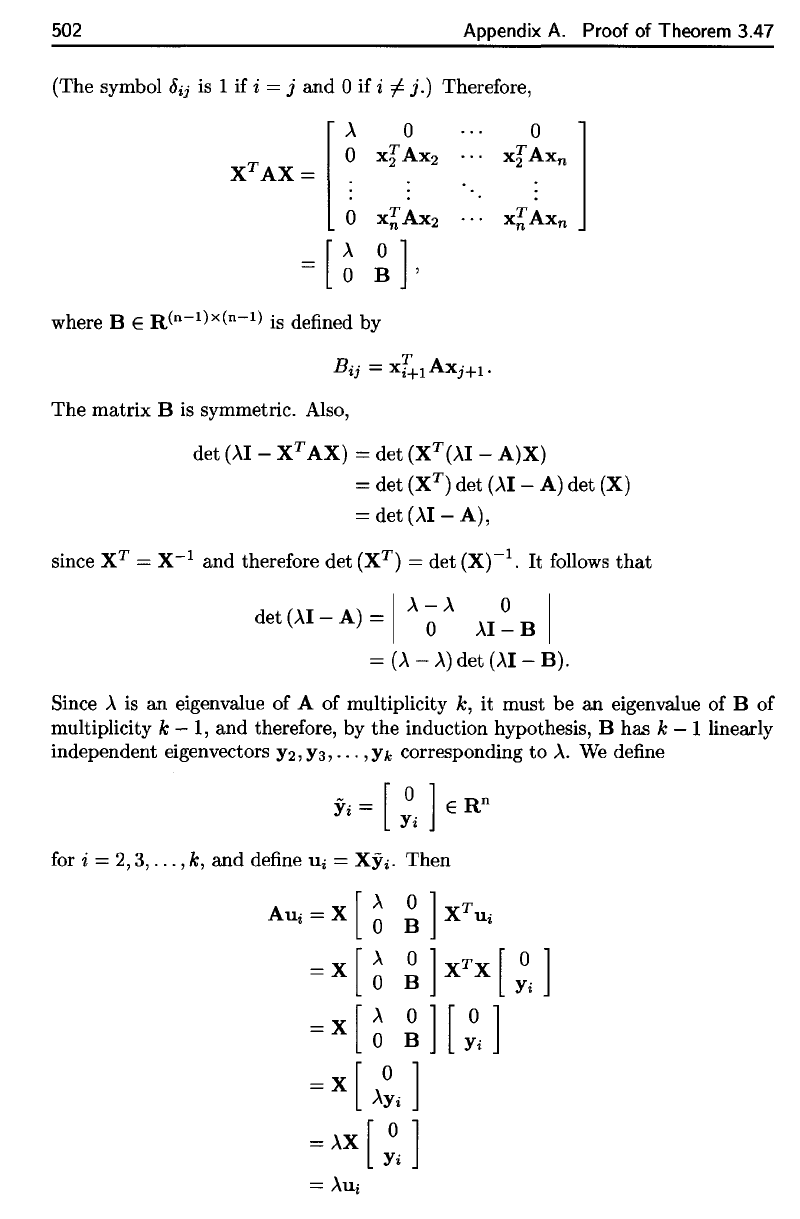
502
Appendix
A.
Proof
of
Theorem 3.47
(The symbol
<%
is 1 if i = j and 0 if i
^
j.)
Therefore,
The
matrix
B is
symmetric. Also,
where
B
<E
RCn-
1
)*^-
1
)
[
s
defined
by
since
X
T
=
X"
1
and
therefore
det
(X
T
)
= det (X)
l
.
It
follows
that
Since
A is an
eigenvalue
of A of
multiplicity
Ar,
it
must
be an
eigenvalue
of B of
multiplicity
k -
1,
and
therefore,
by the
induction hypothesis,
B has k
—
1
linearly
independent eigenvectors
y2,ys,
• • • ,
yfc
corresponding
to A. We
define
for
i =
2,3,...,
k, and
define
Uj
=
XyV
Then
502
Appendix
A.
Proof of Theorem 3.47
(The symbol 8ij
is
1 if i = j
and
0
if
i
¥-
j.)
Therefore,
[
~
xI
~X2
XTAX=
0:
X;AX2
o 1
xIAxn
:::
x
T
lx
n n
=[~
~],
where
BE
R(n-1)x(n-1)
is defined by
The matrix B
is
symmetric. Also,
det
(..xl
-
XT
AX) = det
(XT
(..xl
- A)X)
= det (XT) det
(..xl
- A) det (X)
= det
(..xl
- A),
since X
T
=
X-
1
and therefore det (XT) = det (X)
-1.
It
follows
that
l
..x-..x 0 I
det
(..xl
- A) = 0
..xl
_ B
=
(..x
-..x) det (,\1 -
B).
Since ,\
is
an
eigenvalue of A of multiplicity k, it must be an eigenvalue of B of
multiplicity
k -
1,
and therefore, by the induction hypothesis, B has k - 1 linearly
independent eigenvectors
Y2,
Y3,
...
,Yk
corresponding
to
A.
We
define
for
i = 2,3,
...
, k,
and
define
Ui
=
XYi'
Then
AUi
= X [
~
= X [
~
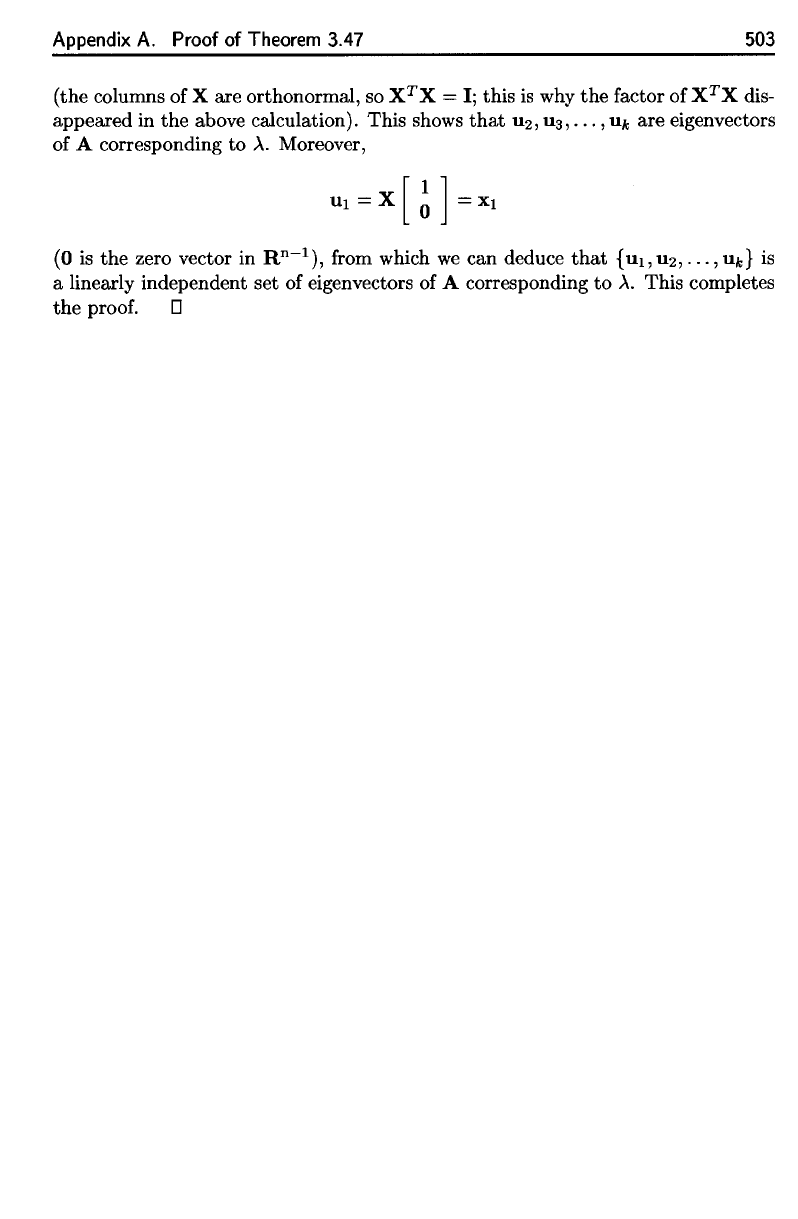
Appendix
A.
Proof
of
Theorem
3.47
503
(the columns
of X are
orthonormal,
so
X
T
X
= I;
this
is why the
factor
of
X
T
X
dis-
appeared
in the
above
calculation).
This shows
that
u
2
,113,...,
u/t
are
eigenvectors
of
A
corresponding
to A.
Moreover,
(0
is the
zero vector
in
R
n
1
],
from
which
we can
deduce
that
{ui,
112,...,
u^}
is
a
linearly independent
set of
eigenvectors
of A
corresponding
to A.
This completes
the
proof.
Appendix
A.
Proof
of
Theorem 3.47
503
(the columns of X are orthonormal, so
XTX
= I; this
is
why
the
factor of
XTX
dis-
appeared in the above calculation). This shows
that
U2, U3,
...
,
Uk
are eigenvectors
of A corresponding to
>..
Moreover,
(0
is
the zero vector in
Rn-l),
from which
we
can deduce
that
{Ul,U2,
...
,Uk}
is
a linearly independent set of eigenvectors of A corresponding
to
>..
This completes
the
proof. D

This page intentionally left blank
This page intentionally left blank
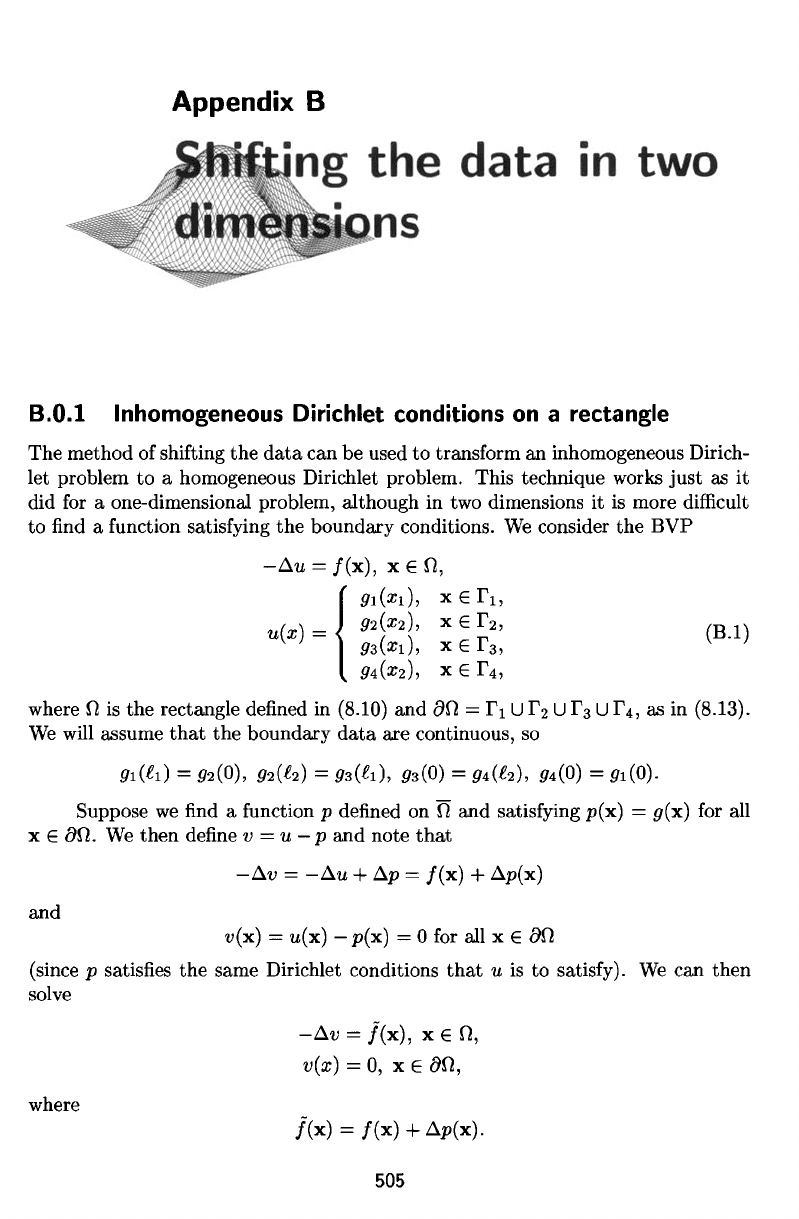
Appendix
B
the
data
in two
B.O.I
Inhomogeneous
Dirichlet
conditions
on a
rectangle
The
method
of
shifting
the
data
can be
used
to
transform
an
inhomogeneous Dirich-
let
problem
to a
homogeneous Dirichlet problem. This technique works just
as it
did
for a
one-dimensional problem, although
in two
dimensions
it is
more
difficult
to find a
function satisfying
the
boundary conditions.
We
consider
the BVP
where
Q,
is the
rectangle defined
in
(8.10)
and
dtt
=
TI
U
T
2
U
T
3
U
T
4
,
as in
(8.13).
We
will assume
that
the
boundary
data
are
continuous,
so
Suppose
we find a
function
p
defined
on
J7
and
satisfying
p(x)
=
#(x)
for all
x
e
dfL
We
then
define
v = u
—
p and
note
that
and
(since
p
satisfies
the
same Dirichlet conditions
that
u is to
satisfy).
We can
then
solve
where
RDR
Shifting
dmensions
Appendix B
eng
the
data
in
two
s
B.O.l Inhomogeneous Dirichlet conditions
on
a rectangle
The method of shifting
the
data
can be used to transform an inhomogeneous Dirich-
let problem
to
a homogeneous Dirichlet problem. This technique works just as
it
did for a one-dimensional problem, although in two dimensions it
is
more difficult
to find a function satisfying
the
boundary conditions.
We
consider
the
BVP
-~u
=
f(x),
x
En,
{
gl(xd,
x E r
1
,
u(x) =
g2(X2),
x E r
2
,
g3(xd, x E r
3
,
g4(X2),
x E r
4
,
(B.1)
where n
is
the rectangle defined in (8.10) and
an
= r
1
U r
2
U
r3
U r
4,
as in (8.13).
We
will assume
that
the
boundary
data
are continuous,
so
gl(fd
=
g2(O),
g2(f
2
) = g3(fI),
g3(O)
= g4(f
2
),
g4(O)
= gl(O).
Suppose
we
find a function p defined on n and satisfying p(x) = g(x) for all
x
E
an.
We
then define v = u - p and note
that
-~v
=
-~u
+
~p
=
f(x)
+
~p(x)
and
v(x) = u(x) - p(x) = 0 for all x E
an
(since p satisfies the same Dirichlet conditions
that
u
is
to
satisfy).
We
can then
solve
where
-~v
=
j(x),
x E
n,
v(x) = 0, x E
an,
j(x)
=
f(x)
+
~p(x).
505

506
Appendix
B.
Shifting
the
data
in two
dimensions
The
result
will
be a
rapidly converging series
for
v,
and
then
u
will
be
given
by
u
= v + p.
We
now
describe
a
method (admittedly rather tedious)
for
computing
a
func-
tion
p
that
satisfies
the
given Dirichlet conditions.
We first
note
that
there
is a
polynomial
of the
form
which
assumes
the
desired boundary values
at the
corners:
A
direct
calculation shows
that
We
then
define
We
have thus replaced each
gi
by a
function
hi
which
differs
from
gi
by a
linear
function,
and
which
has
value zero
at the two
endpoints:
Finally,
we
define
506
Appendix
B.
Shifting
the
data
in
two dimensions
The
result will be a rapidly converging series for v, and
then
u will be given by
u = v +p.
We
now
describe a method (admittedly rather tedious) for computing a func-
tion
p
that
satisfies the given Dirichlet conditions.
We
first note
that
there is a
polynomial of the form
q(X1,
X2)
= a +
bX1
+
CX2
+
dx1X2
which assumes the desired boundary values
at
the corners:
q(O,O)
=
91(0)
= 94(0),
q(£l,O) = 91(£t) = 92(0),
q(£1,£2) =
92(£2)
= 93(£t),
q(0'£2) =
93(0)
=
94(£2).
A direct calculation shows
that
We
then define
a=91(0),
b =
91(£1)
-
91(0)
£1
'
94(£2)
-
94(0)
c=
,
£2
d =
92(£2)
+
91(0)
-
91(£t}
- 94(£2).
£1£2
(
91(£d -
91(0)
)
h
1
(X1)=91(Xl)-
91(0)+
£1
Xl,
(
92(£2)
-
92(0)
)
h2
(X2)
=
92(X2)
-
92(0)
+
£2
X2,
(
93(it) -
93(0)
)
h3(Xt} =
93(Xt}
-
93(0)
+
i1
Xl,
(
94(i2) -
94(0)
)
h4
(X2)
=
94(X2)
-
94(0)
+
£2
X2·
We
have thus replaced each 9i by a function hi which differs from 9i by a linear
function, and which has value zero
at
the two endpoints:
Finally,
we
define

Appendix
B.
Shifting
the
data
in two
dimensions
507
The
reader should notice
how the
second term interpolates between
the
boundary
values
on
FI
and
F
3
,
while
the
third term interpolates between
the
boundary values
on
F
2
and
IT^.
In
order
for
these
two
terms
not to
interfere with each other,
it is
necessary
that
the
boundary
data
be
zero
at the
corners.
It was for
this
reason
that
we
transformed
the
g^s
into
the
h^s.
The first
term
in the
formula
for p
undoes
this transformation.
It is
straightforward
to
verify
that
p
satisfies
the
desired boundary conditions.
For
example,
Thus
the
boundary condition
on
FI
is
satisfied. Similar calculations show
that
p
satisfies
the
desired boundary conditions
on the
other
parts
of the
boundary.
Example
B.I.
We
will
solve
the BVP
by
the
above
method,
where
fJ
is the
unit
square:
To
compute
p, we
define
Appendix
B.
Shifting
the
data
in
two dimensions
507
The reader should notice how
the
second term interpolates between
the
boundary
values on
r 1 and r
3,
while
the
third
term interpolates between the boundary values
on
r 2 and r
4.
In order for these two terms not
to
interfere with each other,
it
is
necessary
that
the
boundary
data
be zero
at
the corners.
It
was for this reason
that
we
transformed the gi's into the hi'S. The first term in
the
formula for p undoes
this transformation.
It
is
straightforward
to
verify
that
p satisfies the desired boundary conditions.
For example,
h3(xd - h1(xd
P(X1'0)
= a +
bX1
+
cO
+ dx10 + h1(xd +
£2
0
h
(0)
h2(0)-h4(0)
+ 4 +
£1
Xl
= a +
bX1
+ h1(xd (since h
4
(0)
= h
2
(0)
=
0)
= gl(O) +
bX1
+
gl(xd
-
(gl(O)
+
bX1)
=
gl(xd·
Thus the boundary condition on r 1
is
satisfied. Similar calculations show
that
p
satisfies
the
desired boundary conditions on
the
other
parts
of the boundary.
Example
B.1.
We will solve the
BVP
by
the
above
method, where n is the
unit
square:
To
compute p,
we
define
a=91(0)=0,
b = 91(1) - gl(O) = 1
1 '
c = 94(1) - 94(0) = 1
1 '
x E r
1
,
x E r
2
,
x E r
3
,
x E
f4
d =
g2(1)
+ gl(O) -
gl(l)
-
g4(1)
=
-2
1·1
'
h1
(Xl) =
xi
-
(0
+
xd
=
xi
- Xl,
h
2
(X2)
=
1-
x~
-
(1
+
(-I)x2)
=
X2
-
x~,
h3(xd =
(1-
X1)2
-
(1
+
(-I)X1)
=
xi
- Xl,
h4(X2)
=
X2
-
(0
+
X2)
=
o.
(B.2)
